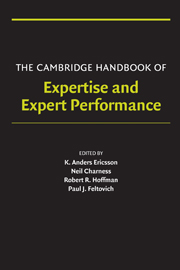Book contents
- Frontmatter
- Contents
- Acknowledgments
- Contributors
- PART I INTRODUCTION AND PERSPECTIVE
- PART II OVERVIEW OF APPROACHES TO THE STUDY OF EXPERTISE – BRIEF HISTORICAL ACCOUNTS OF THEORIES AND METHODS
- PART III METHODS FOR STUDYING THE STRUCTURE OF EXPERTISE
- PART IV METHODS FOR STUDYING THE ACQUISITION AND MAINTENANCE OF EXPERTISE
- PART V DOMAINS OF EXPERTISE
- PART V.A PROFESSIONAL DOMAINS
- PART V.B ARTS, SPORTS, & MOTOR SKILLS
- 26 Music
- 27 Expert Performance in Sport: A Cognitive Perspective
- 28 Artistic Performance: Acting, Ballet, and Contemporary Dance
- 29 Perceptual-Motor Expertise
- PART V.C GAMES AND OTHER TYPES OF EXPERTISE
- PART VI GENERALIZABLE MECHANISMS MEDIATING EXPERTISE AND GENERAL ISSUES
- Author Index
- Subject Index
- References
26 - Music
from PART V.B - ARTS, SPORTS, & MOTOR SKILLS
- Frontmatter
- Contents
- Acknowledgments
- Contributors
- PART I INTRODUCTION AND PERSPECTIVE
- PART II OVERVIEW OF APPROACHES TO THE STUDY OF EXPERTISE – BRIEF HISTORICAL ACCOUNTS OF THEORIES AND METHODS
- PART III METHODS FOR STUDYING THE STRUCTURE OF EXPERTISE
- PART IV METHODS FOR STUDYING THE ACQUISITION AND MAINTENANCE OF EXPERTISE
- PART V DOMAINS OF EXPERTISE
- PART V.A PROFESSIONAL DOMAINS
- PART V.B ARTS, SPORTS, & MOTOR SKILLS
- 26 Music
- 27 Expert Performance in Sport: A Cognitive Perspective
- 28 Artistic Performance: Acting, Ballet, and Contemporary Dance
- 29 Perceptual-Motor Expertise
- PART V.C GAMES AND OTHER TYPES OF EXPERTISE
- PART VI GENERALIZABLE MECHANISMS MEDIATING EXPERTISE AND GENERAL ISSUES
- Author Index
- Subject Index
- References
Summary
Research Approaches to Individual Differences in Music
Individual differences in musical achievement have at all times awed musicians and audiences alike. In former times, royalty and nobility invited outstanding musicians to perform in their salons. Today, the general public crowds the concert halls when certain celebrities perform while other concerts are scarcely attended. Sometimes, special attractions such as child prodigies or musical savants capture the attention of the mass media.
Scientific attempts to understand individual differences have existed for a long time. Barrington (1770) investigated Mozart's early performance achievements and described it in some detail. Such single-case studies are highly informative. However, they usually do not suffice for modern scientific standards. They merely document high achievements under controlled conditions and attribute them to exceptional levels of talent. Doubts can be expressed about the accuracy and reliability of the information presented in biographies of famous musicians. More recent biographies mention skill acquisition explicitly from the perspective of musical talent research. This research explains exceptional performance as based in innate musical capacities.
Billroth's (1895) “Who is musical?” can be seen as a starting point for research on musical abilities in the 19th century. Later in the 1920s and 30s Seashore developed his “Measures of musical talents”, which assessed subjects' perceptual discrimination abilities (Seashore, 1938/1967). With few exceptions, such as Wellek's attempt in 1939 to identify racial differences in musical abilities (Wellek, 1970), most music aptitude tests have tried to predict the potential for music performance (Boyle, 1992, for a review).
- Type
- Chapter
- Information
- The Cambridge Handbook of Expertise and Expert Performance , pp. 457 - 470Publisher: Cambridge University PressPrint publication year: 2006
References
- 36
- Cited by

